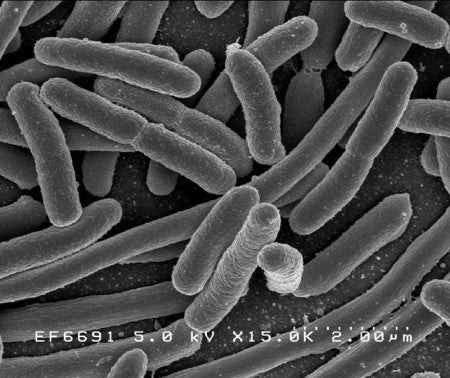Before any mission to Mars launches, NASA’s scientists and engineers put every tiny component of the robot through rigorous sterilization procedures, ensuring the lander or rover is bacteria-free. This isn’t because NASA has an extreme case of obsessive compulsive disorder, it’s because they want to keep the Martian surface as pristine from Earth Brand™ bugs as possible.
Why?
Imagine if a struggling colony of Martian bacteria encountered some germs from Earth. Not only would this be a big let-down as far as first contact with an alien species goes (it’s not as if our bacteria would make very good Earth ambassadors), it could wipe out any trace of the native life.
Also, what if Earth Brand™ bacteria has set-up home after hitchhiking in the treads of one of the Mars Exploration Rovers wheels? It would be a shame if it got scooped up by a future life-finding mission; the first life discovered on Mars would actually be Earth life living on Mars!
The idea that hardy bacterial life could survive the rigors of space and the harshness of the Martian atmosphere isn’t such a crazy idea. What’s more, we can’t guarantee that our Mars robots are 100 percent clean.
Recent studies have shown that a surprisingly large number of microbes survive the sterilization procedures and remain attached to the spacecraft at the time of launch. And here’s the kicker: only the toughest bugs survive to this point, the same bugs that could make ideal Mars colonists.
The University of Central Florida researchers tortured several different resilient types of microbe including acinetobacter, bacillus, escherichia, staphylococcus and streptococcus to see what it took to kill them. They froze them, dried them, exposed them to very low pressures and doused them in ultraviolet light (pretty much the conditions they can expect when the microbes arrive at their holiday destination), and they found that some survived.
“If long-term microbial survival is possible on Mars, then past and future explorations of Mars may provide the microbial inoculum for seeding Mars with terrestrial life. Thus, a diversity of microbial species should be studied to characterize their potential for long term survival on Mars.” –UCF researchers.
Escherichia coli for example, was quite happy camping out in these conditions, although it didn’t feel like multiplying much. One strain of E. coli is responsible for scary food poisoning in humans, so littering the Martian surface with a bug you might find under a subway toilet seat, whether it multiplies or not, doesn’t seem sanitary.
Needless to say we need to improve our spacecraft-cleaning methods before we potentially turn Mars into Earth’s petri dish.
Source: Discovery News, Are We Infecting Mars With Our Germs?, by Ian O’Neill, Thu Apr 29, 2010 02:52 AM ET. Image: A human menace: E. coli, up close (United States Department of Health and Human Services)
Source for Discovery News story: American Society for Microbiology.
